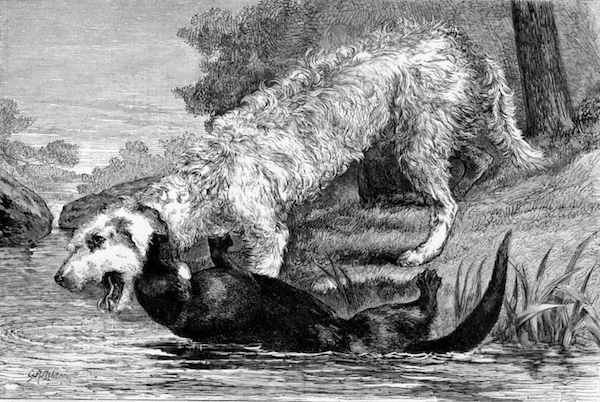
“Crushing.”
It’s not a word typically associated with anything good: Crush injury, crush in, crush on, crush it, crush out. Outside of “girl crush” and “man crush,” the most benign wording we could find using the word was Captain Crunch, and even then, you want to watch out for the 80 percent of adults who snack on the cereal outside of breakfast. Hungry grown-ups. Be afraid.
All that said, the word still appears in a couple of breed standards. Can you guess which two?
One is the Afghan Hound. The other is the Otterhound, the focus of this post.
The breed might be known for his status as a vulnerable breed, his adorable tousled look, and those webbed feet, but a description of his bite has to be the most unique among hound breeds for this reason: A phrase in its breed standard reads: The jaws are powerful and capable of a crushing grip.
It is one of only two AKC breed standards that includes the word, “crushing.”
In some ways, the Otterhound reminds us of another species, Sea Otters. They have that dense fur and adorable muppet look, but Otters also have a crushing bite. It’s because of what they eat: Mollusks, echinoderms, and other hardened prey. They manipulate them with dexterous hands, then crush them with expanded cheek teeth.
Otterhounds don’t eat Mollusks. Historically, they hunted otters, and while otters look cute and cuddly, they can grow up to four feet long and weigh up to 30 pounds. If an otter feels threatened, which it surely does by a dog looking for it, its heavy, muscular body and sharp claws are enough to overpower small people. Many Otterhounds succumbed to an Otter’s fierceness after being pulled down underwater. An Otterhound needed to be able to kill the otter if only to save its own life.
Surprisingly, in modern times there have been around forty cases of otter attacks against humans. As a member of the weasel family, otters are tenacious and dangerous, so it took a tough, strong jawed dog to bring one down. In the days of King John I, King Henry II and Queen Elizabeth, all said to keep packs of Otterhounds, the otter was a threat to the livelihood of those who lived on fishing, and an obstacle to the growth of welfare of the landowners. The Otterhound’s job was to control that “pest.”
Image: “Otterhound dog and Otter Fight to the Death at the River,” an antique engraving from 1875 as published in “Harper’s Weekly”

I learn so much about so many different breeds on your posts! Can you give me an ETA when the Herding Group cards will arrive? Thank you!